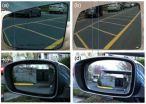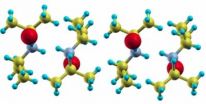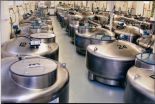(Press-News.org) WASHINGTON, Jan. 28, 2013—A new optical prescription for automobile side-view mirrors may eliminate the dreaded "blind spot" in traffic without distorting the perceived distance of cars approaching from behind. As described in a paper published today in the Optical Society's (OSA) journal Optics Letters, objects viewed in a mirror using the new design appear larger than in traditional side-view mirrors, so it's easier to judge their following distance and speed.
Today's motor vehicles in the United States use two different types of mirrors for the driver and passenger sides. The driver's side mirror is flat so that objects viewed in it are undistorted and not optically reduced in size, allowing the operator to accurately judge an approaching-from-behind vehicle's separation distance and speed. Unfortunately, the optics of a flat mirror also create a blind spot, an area of limited vision around a vehicle that often leads to collisions during merges, lane changes, or turns. The passenger side mirror, on the other hand, possesses a spherical convex shape. While the small radius of curvature widens the field of view, it also causes any object seen in it to look smaller in size and farther away than it actually is. Because of this issue, passenger side mirrors on cars and trucks in the United States must be engraved with the safety warning, "Objects in mirror are closer than they appear." In the European Union, both driver and passenger side mirrors are aspheric (One that bulges more to one side than the other, creating two zones on the same mirror).The inner zone—the section nearest the door—has a nearly perfect spherical shape, while the outer zone— the section farthest from the door—becomes less and less curved toward the edges. The outer zone of this aspheric design also produces a similar distance and size distortion seen in spherical convex designs.
In an attempt to remedy this problem, some automotive manufacturers have installed a separate, small wide-angle mirror in the upper corner of side mirrors. This is a slightly domed square that provides a wide-angle view similar to a camera's fisheye lens. However, drivers often find this system to be a distracting as well as expensive addition.
A simpler design for a mirror that would be free of blind spots, have a wide field of view, and produce images that are accurately scaled to the true size of an approaching object—and work for both sides of a vehicle—has been proposed by researchers Hocheol Lee and Dohyun Kim at Hanbat National University in Korea and Sung Yi at Portland State University in Oregon. Their solution was to turn to a progressive additive optics technology commonly used in "no-line multifocal" eyeglasses that simultaneously corrects myopia (nearsightedness) and presbyopia (reduced focusing ability).
VIDEO:
This video demonstrates how the progressive mirror provides an accurate depiction of the distance to approaching-from-behind vehicles. The appearance of the vehicle out the side window just as it leaves...
Click here for more information.
"Like multifocal glasses that give the wearer a range of focusing abilities from near to far and everything in between, our progressive mirror consists of three resolution zones: one for distance vision, one for close-up viewing and a middle zone making the transition between the two," says Lee. "However, unlike glasses where the range of focus is vertically stacked [from distance viewing on top to close-up viewing on bottom], our mirror surface is horizontally progressive."
Lee says that a driver's side mirror manufactured with his team's new design would feature a curvature where the inner zone is for distance viewing and the outer zone is for near-field viewing to compensate for what otherwise would be blind spots. "The image of a vehicle approaching from behind would only be reduced in the progressive zone in the center," Lee says, "while the image sizes in the inner and outer zones are not changed."
The horizontal progressive mirror, Lee says, does have some problems with binocular disparity (the slight difference between the viewpoints of a person's two eyes) and astigmatism (blurring of a viewed image due to the difference between the focusing power in the horizontal and vertical directions). These minor errors are a positive trade off, the researchers feel, to gain a mirror with a greatly expanded field of view, more reliable depth perception, and no blind spot.
To prove the merits of their design, the researchers used a conventional glass molding process to manufacture a prototype horizontal progressive mirror. They were able to produce a mirror with more than double the field of view of a traditional flat mirror.
Other wide-angle designs have also been proposed, but the new design described today in the Optics Letters paper offers a particularly easy-to-manufacture approach to the problem of blind spots by seamlessly integrating just three zones.
The researchers claim that the manufacturing cost of their proposed mirror design would be cheaper than the mirror design with the added small wide-angle viewing section. Since mirror designs are stipulated by national automobile regulations, the new design would need to be approved for use in the United States before appearing on cars here.
INFORMATION:
Paper: "Horizontally progressive mirror for blind spot detection in automobiles," H. Lee, D. Kim, S. Yi, Optics Letters, Vol. 38, Issue 3, pp. 317 – 319 (2013).
EDITOR'S NOTE: An image and video clip of the new mirror are available to members of the media upon request. Contact Brielle Day.
About Optics Letters
Published by the Optical Society (OSA), Optics Letters offers rapid dissemination of new results in all areas of optics with short, original, peer-reviewed communications. Optics Letters covers the latest research in optical science, including optical measurements, optical components and devices, atmospheric optics, biomedical optics, Fourier optics, integrated optics, optical processing, optoelectronics, lasers, nonlinear optics, optical storage and holography, optical coherence, polarization, quantum electronics, ultrafast optical phenomena, photonic crystals, and fiber optics. This journal, edited by Alan E. Willner of the University of Southern California and published twice each month, is where readers look for the latest discoveries in optics. Visit www.OpticsInfoBase.org/OL.
About OSA
Uniting more than 180,000 professionals from 175 countries, the Optical Society (OSA) brings together the global optics community through its programs and initiatives. Since 1916 OSA has worked to advance the common interests of the field, providing educational resources to the scientists, engineers and business leaders who work in the field by promoting the science of light and the advanced technologies made possible by optics and photonics. OSA publications, events, technical groups and programs foster optics knowledge and scientific collaboration among all those with an interest in optics and photonics. For more information, visit www.osa.org.
Progressive optics for side mirrors ends automobile blind spots without distorting view
2013-01-28
ELSE PRESS RELEASES FROM THIS DATE:
Pandemic controversies: The global response to pandemic influenza must change
2013-01-28
'Evil' scientists, deadly viruses and terrorist plots are usually the preserve of Hollywood blockbusters. But when it comes to pandemic influenza, it is the stuff of real life. As controversy about research into the H5N1 bird flu virus continues, a new paper argues for a complete overhaul of current approaches to pandemic preparedness.
To Pandemic or Not? Reconfiguring Global Responses to Influenza, by Dr Paul Forster, of the ESRC STEPS Centre, investigates the H1N1 swine flu pandemic of 2009-10 and sets out some vital lessons if we are to prepare for pandemic influenza ...
Fewer people adding salt at the table
2013-01-28
The number of people in England adding salt to food at the table fell by more than a quarter in the five years following a national campaign, according to research published in the British Journal of Nutrition.
In 2003, the UK Food Standards Agency and the Department of Health launched a national salt reduction campaign to raise public awareness of the impact of salt on health and to work with the food industry to reduce the amount of salt in processed foods.
Although previous research found that the national campaign led to an overall reduction in salt intake, this ...
Novel materials: Smart and magnetic
2013-01-28
Novel, smart materials like shape memory alloys very often display so-called glass-like magnetism. Other smart materials with similar properties include those which, when exposed to a magnetic field, change their electrical resistance, known as manganites, or change their temperature, known as magnetocaloric materials. Kaustav Mukherjee and his colleagues from the Consortium for Scientific Research Indore in India studied a key stage in the formation of such a magnetic glass material, called Pr0.5 Ca0.5 Mn0.975 Al0.025 O3, in a paper about to be published in EPJ B.
They ...
A new material for environmentally friendlier electronics
2013-01-28
The electronics industry has a remarkable impact on the environment, yet research is devising new solutions to reduce it. Among these, a new compound with an unutterable name, the diisopropylammonium bromide (DIPAB), a new ferroelectric material created by an international team of researchers that include Massimo Capone and Gianluca Giovannetti of Istituto Officina dei Materiali at CNR and of the International School for Advanced Studies of Trieste (SISSA), whose research has been just published in Science magazine.
"A ferroelectric material has properties analogous ...
A safer way to vaccinate
2013-01-28
CAMBRIDGE, MA -- Vaccines usually consist of inactivated viruses that prompt the immune system to remember the invader and launch a strong defense if it later encounters the real thing. However, this approach can be too risky with certain viruses, including HIV.
In recent years, many scientists have been exploring DNA as a potential alternative vaccine. About 20 years ago, DNA coding for viral proteins was found to induce strong immune responses in rodents, but so far, tests in humans have failed to duplicate that success.
In a paper appearing in the Jan. 27 online ...
Some health benefits of berries may not make it past your mouth
2013-01-28
COLUMBUS, Ohio – Research has suggested that compounds that give colorful fruits their rich hues, especially berries, promote health and might even prevent cancer. But for the first time, scientists have exposed extracts from numerous berries high in those pigments to human saliva to see just what kinds of health-promoting substances are likely to survive and be produced in the mouth.
It's too early to name the best berry for health promotion based on this initial work. But the researchers have discovered that two families of pigments that provide berries with their colors, ...
Soya protein can be replaced by rapeseed protein
2013-01-28
Jena (Germany) Today, more than 500 million people are suffering from a lack of adequate protein in their diet. Each year, the number of human beings increases by 80 million, a figure which is equivalent to the present population of Germany. Thus, providing enough food, particularly sufficient protein for the increasing populace is a challenging task for societies all over the world. On a prospective basis, a progressively smaller proportion of human protein requirement can be provided by animal proteins such as meat, eggs, and milk. "However, by feeding valuable plant ...
Study of human specimen collections in the US offers first look at their huge diversity
2013-01-28
Chapel Hill, N.C. – Biobanks are organizations that collect, store and share human specimens (e.g., blood, solid tissues, hair) for research purposes. The rise of the human genome project and of large-scale genetics studies have spurred a dramatic increase in the number of biobanks in the last decade, increasing their importance in biomedical research.
But until now, biobanks in the U.S. have never been studied systematically, leaving few clear details as to how they are run or the policies and practices they use in managing their work.
A new study from the University ...
Discovering the missing 'LINC' to deafness
2013-01-28
Tel Aviv — Because half of all instances of hearing loss are linked to genetic mutations, advanced gene research is an invaluable tool for uncovering causes of deafness — and one of the biggest hopes for the development of new therapies. Now Prof. Karen Avraham of the Sackler Faculty of Medicine at Tel Aviv University has discovered a significant mutation in a LINC family protein — part of the cells of the inner ear — that could lead to new treatments for hearing disorders.
Her team of researchers, including Dr. Henning Horn and Profs. Colin Stewart and Brian Burke of ...
With hot air treatment, bacteria fly the coop
2013-01-28
This press release is available in Spanish.Poultry producers can reduce bacterial cross-contamination in poultry cages by treating the cages with forced air that's been heated to 122 degrees Fahrenheit, according to a study by U.S. Department of Agriculture (USDA) scientists.
While being transported in coops on trucks, poultry that have bacteria such as Campylobacter can contaminate, through their feces, other poultry that are free of pathogens. Those disease-causing bacteria can then be passed on to the next group of birds during the next trip, and so forth, unless ...




